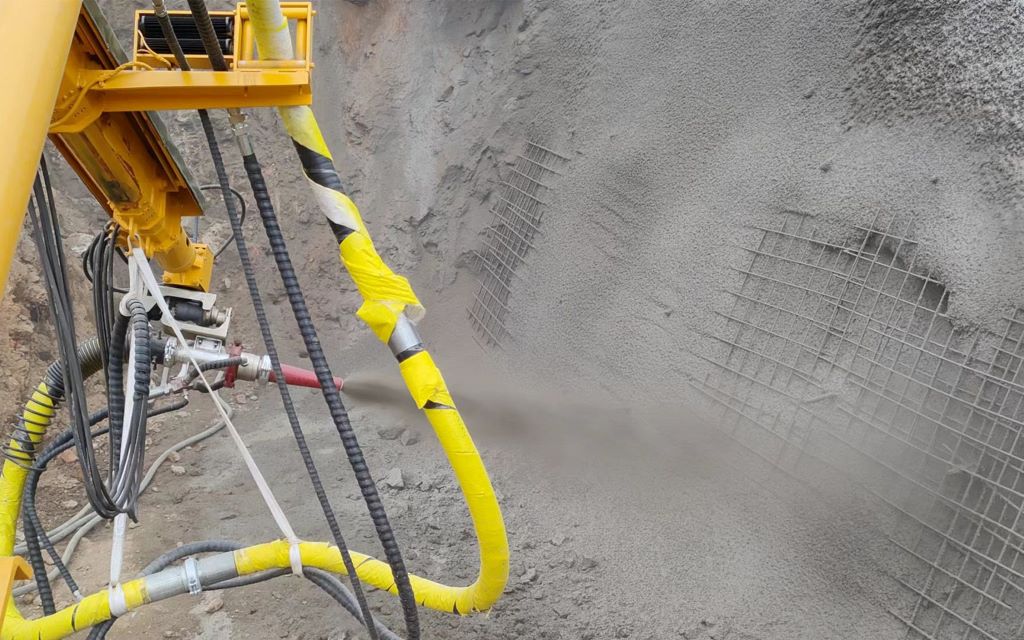Wet Concrete Spraying Process and Requirements Using a wet shotcrete sprayer:

1. Wet Concrete Spraying Process Using a wet shotcrete sprayer
The wet spraying process using a wet shotcrete sprayer is key to reducing rebound (typically ≤15%) and ensuring support quality. It requires following the "preparation first, spraying second, and parameter control" process:
1. Pre-spraying Preparation
① Clean the spraying surface: Remove dust and loose rocks. If there is accumulated water on the spraying surface, drain it first (accumulated water will reduce the bond strength of the concrete). If the spraying surface is a rock surface, blow the surface with high-pressure air beforehand.
② Mark the thickness control line: Mark the spraying surface with a steel bar head or red paint according to the designed spraying thickness (e.g., initial support thickness of 250mm for a tunnel) to ensure uniform spraying thickness.
2. Spraying Parameter Control
① Spraying distance: Maintain a distance of 1.0-1.5 meters between the nozzle and the spraying surface (too close can increase rebound, too far can cause concrete segregation).
② Spray Angle: The nozzle should be perpendicular to the sprayed surface (for special areas such as corners, the angle can be adjusted to 10°-15° to avoid missed areas).
③ Spraying Sequence: Follow the principle of "segmented and layered, bottom-up, concave first, then convex." Each segment should be ≤ 6 meters long, and each layer should be 50-80 mm thick (to avoid excessive concrete fallout caused by spraying too thick at once).
3. Treatment of Special Areas
① Areas with dense reinforcement (such as steel supports and anchor bolt heads): Slow down the spraying speed. Spray between the reinforcement bars first to ensure that the concrete fills the gaps, then cover the entire area to avoid voids.
② Tunnel vault: Use a "spiral spraying" method (spraying from the arch foot to the vault). At the same time, increase the wind pressure appropriately (0.5-0.6 MPa) to ensure the concrete is densely packed.
II. Wet-Shotcrete Requirements for Wet-Shotcrete
The mix proportion, condition, and storage of wet-shot concrete sprayed by a wet-shotcrete trolley directly impact the quality of the spraying (such as strength, adhesion, and impermeability) and require strict control:
1. Concrete Mix Compliance
① Control the water-cement ratio (usually 0.4-0.5), sand content (45%-55%), and aggregate gradation (maximum coarse aggregate size ≤16mm to avoid clogging of the delivery pipe) according to design requirements. Accelerators added must be compatible with the cement (liquid accelerators are preferred, with a dosage of 2%-4%).
② Concrete that has segregated, prematurely set (exceeding the initial setting time), or contains impurities (such as oversized stone or mud lumps) is prohibited.
2. Concrete Condition Monitoring
① Check the concrete slump before operation: For ground operations, the slump should be controlled at 120-160mm; for operations at height (such as tunnel vaults), the slump should be controlled at 140-180mm (to ensure fluidity and avoid pipe clogging).
② Concrete must be continuously stirred during transportation (at a speed of 2-4 rpm) to prevent segregation. If the transportation time exceeds one hour, the slump must be retested and any unsatisfactory conditions must be discarded.
3. Material Storage Specifications
Cement and accelerators must be stored in a moisture-proof, well-ventilated warehouse. Accelerators must be protected from direct sunlight to prevent degradation. Sand and gravel aggregates must be stored separately to avoid mixing.





